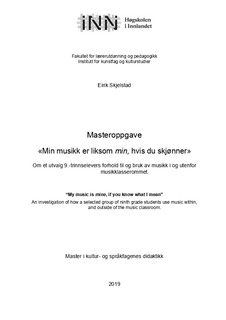| dc.contributor.author | Skjelstad, Eirik | |
| dc.date.accessioned | 2020-01-29T09:13:59Z | |
| dc.date.available | 2020-01-29T09:13:59Z | |
| dc.date.issued | 2019 | |
| dc.identifier.uri | http://hdl.handle.net/11250/2638479 | |
| dc.description | Mastergradsoppgave i kultur- og språkfagenes didaktikk, Høgskolen i Innlandet, 2019. | nb_NO |
| dc.description.abstract | Norsk:
Denne masteroppgaven undersøker hvordan elever i en utvalgt 9.klasse tar i bruk musikk i og utenfor musikkundervisningen på skolen. Gjennom klasseromsobservasjon og intervjuer med elevene settes fokus på elevenes egne utsagn om hvordan de opplever å delta i musikkundervisningen, med hvilken musikk og hvordan den generelle samhandlingen foregår innenfor musikkundervisningens kontekst. I oppgaven sees musikkundervisning og musikklasserommet i et utvidet perspektiv. Jeg har valgt å anerkjenne at elevenes bruk av musikk utenfor den formelle institusjonen kan sies å være en del av deres musikalske opplæring (Folkestad, 2006; Dyndahl & Ellefsen, 2011), og fokuserer derfor både på musikken som arbeides med i undervisningssammenheng så vel som den de oppgir at de omgir seg med til daglig.
Teorigrunnlaget er forankret i en poststrukturalistisk forståelse der begreper som kjønn, ungdom og identitet får nye konnotasjoner og betydninger. Det legges også vesentlig vekt på betydningen av smak og habitus (jf. Bourdieus kultursosiologi, 1979/1995), noe jeg også argumenterer for at kan sees i sammenheng med posisjoneringsteori (Davies & Harré, 1990). Fokus på elevenes bevissthet rundt egen bruk av musikk diskuteres også, ved hjelp av affordance-begrepet (DeNora 2000). Datamaterialet er en kombinasjon av feltnotater fra undervisningen og lydopptak fra intervjuene. Informantene er et utvalg 9.trinnselever og en musikklærer. Datainnsamlingen foregikk over en periode på 7 uker, mellom skolens høst- og juleferie.
Studien viser en rekke eksempler på hvordan elevene posisjonerer seg selv og hverandre i musikktimene. Dette kommer til syne både i klasserommet i samtaler om musikksmak, der noens musikk valideres framfor andres, og der enkelte elever har større forhandlingsrom enn andre når det gjelder å uttrykke seg musikalsk eller å velge å rette seg etter/stå utenfor bestemte smaksregimer. Dette gjenspeiler seg også i hvilken musikk elevene arbeider med på skolen, der noen kan vise fram musikk som kan sies å avvike fra normalen, mens andre er mer opptatt av «likbarhet» og medelevenes respons på den valgte musikken. Studien viser også hvilken betydning klasseledelse og implementering av gode trivselsregler har for å skape et klassemiljø der elevene føler at de kan delta og samhandle med hverandre i en trygg kontekst. | nb_NO |
| dc.description.abstract | English:
This thesis will investigate how students in a Norwegian ninth grade classroom use music within and outside of the music classroom. Through classroom observations and interviews,I investigate students’ own point of view on how they experience their participation in the music classes, and how this participation takes place within the context of general musiceducation. In the thesis, music education and the music classroom are seen in an extendedperspective; I argue that the students’ use of music in their everyday life outside of the formal educational institution can be regarded as a part of their musical education (Folkestad, 2006; Dyndahl & Ellefsen, 2011). Thus I am focusing both on the music they know from the classroom and the music they listen to in situations outside of school.
The theoretical foundation of this thesis is anchored in a poststructuralist understanding, where concepts such as gender, youth and identity get new connotations and meanings. Significant emphasis is also placed on the importance of taste and habitus (Bourdieu’s cultural sociology, 1979/1995), which I also argue can be seen in connection with positioning theory (Davies & Harré, 1990). The focus on the students’ awareness of self-use of music is also discussed, with help of the term of affordance (DeNora, 2000). The data material is a combination of field notes from the classroom and audio recordings from the interviews. The participants are a group of ninth grade pupils and one music teacher. The data collection took place over a period of 7 weeks, between the school’s Autumn and Christmas holidays.
The study shows a number of examples of how the students position themselves and each other in the music lessons. This is evident in conversations about music tastes, where certain types of music are validated over others. Some students have larger negotiating space than others when it comes to expressing themselves musically, or choosing to adhere to / stand outside of specific taste regimes. This is also reflected in the music that is brought to school by the students, where some can share music that differs from the “classroom normal”, while others are more concerned with the music’s likability and the other students’ response to it. The study also shows the importance of classroom management and implementation of a good code of conduct to create a class environment in which the students feel that they can participate and interact with each other within a safe context. | nb_NO |
| dc.language.iso | nob | nb_NO |
| dc.subject | MIKS | nb_NO |
| dc.subject | musikk | nb_NO |
| dc.subject | ungdomsskolen | nb_NO |
| dc.title | «Min musikk er liksom min, hvis du skjønner» Om et utvalg 9.-trinnselevers forhold til og bruk av musikk i og utenfor musikklasserommet. | nb_NO |
| dc.title.alternative | “My music is mine, if you know what I mean” An investigation of how a selected group of ninth grade students use music within, and outside of the music classroom. | nb_NO |
| dc.type | Master thesis | nb_NO |
| dc.subject.nsi | VDP::Humaniora: 000::Musikkvitenskap: 110 | nb_NO |
| dc.source.pagenumber | 108 | nb_NO |
